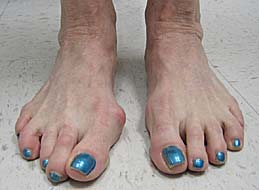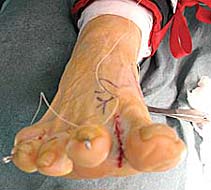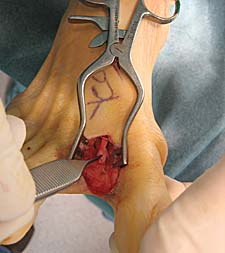New soft tissue release technique offers an effective treatment for bunions
Surgeons performed the first web space release in 88 bunionectomies.
Surgeons at the University of Texas Medical Branch Hospitals, Galveston, recently reported that using a new sequential first web space soft tissue release technique was effective for treating bunions.
Most of the 2-cm incision for the new release approach is made in the web fold. It allowed them to visualize the structure from side to side and also from underneath. This helped surgeons avoid nerve injuries and it produced better cosmesis than traditional releases done with incisions on the top of the foot. The technique resulted in “no hallux varus, most importantly,” said Vinod K. Panchbhavi, MD, FRCS.
Panchbhavi and developer Saul Trevino, MD, use the technique and teach it to their fellows and residents. During the American Orthopaedic Foot and Ankle Society 21st Annual Summer Meeting, Panchbhavi presented their results in 76 patients who underwent 88 bunion procedures from 1998 to 2003.
|
|
See structures better
“If the incision is primarily in the web space, you get a better visualization of the conjoint tendon and the plantar digital neurovascular structures, and also it seems that you can assess the reduction of the head of the first metatarsal in a better way,” Panchbhavi said.
The flexor hallucis brevis and adduction hallucis form the conjoint tendon.
Panchbhavi and Trevino studied their results retrospectively. They found no infections or cases of hallux varus at any follow-up points.
Their earlier cadaver work proved that the sequential release technique could be used to safely release the conjoint tendon, and it only cut the hallux brevis adductor insertion of the conjoint tendon, not the flexor muscle, Panchbhavi told Orthopedics Today.
Courtesy of Vinod K. Panchbhavi |
“You can, in addition, eliminate inadvertent release of the hallux brevis tendon, which can result in hallux varus,” he said during his presentation.
Better than a McBride?
The new technique differs from the original McBride procedure, which involves a dorsal incision and excising the fibular or lateral sesamoid.
Intraoperatively, the surgeons made a 2-cm incision, which they moved from the top of the foot, which is where it is made in the McBride technique, to between the first and second toes. “You can limit your cut or you can be very precise to the extent that you want to release the contracted structures,” Panchbhavi explained. Due to greater precision and visualization, undercutting the structures or overcutting them may also be avoided.
This approach appears to make it easier to single out the adductor muscle from within the conjoint tendon. “If you look from in between the toes, you may be able to limit the cut precisely to the adductor only,” he said.
Surgeons closed the incisions by placing the sutures level with the neck of the first and second metatarsal. “The scar is more hidden in the web space.”
Another advantage of the new technique is it allows thorough examination of the sesamoid metatarsal articular cartilage, he said.
Patients undergo postop rehabilitation similar to that used following other bunion treatments.
Panchbhavi said his paper was accepted for publication in Techniques in Foot & Ankle Surgery.
For more information:
- Panchbhavi VK, Trevino S. First web space soft tissue release: a new sequential approach. Presented at the American Orthopaedic Foot and Ankle Society 21st Annual Summer Meeting. July 14-17, 2005. Boston.



